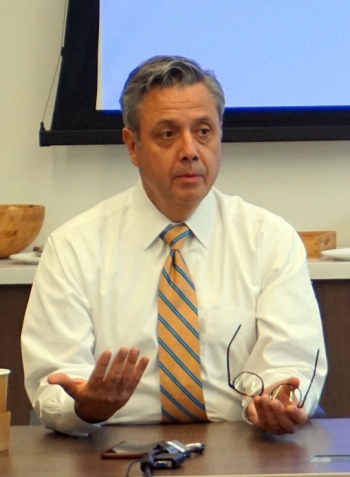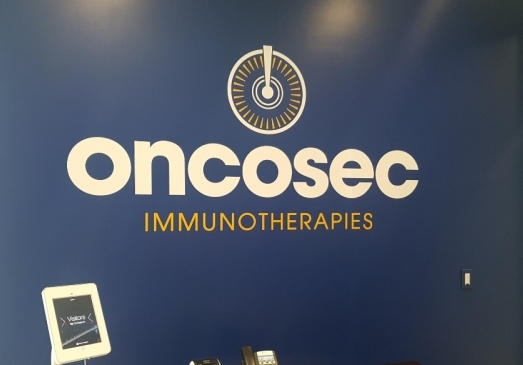기업
Alphaholdings, strategy the Joint Use of Oncosec IL-12·Keytruda
by Jongwon Jang
Local Medication of Plasmid IL-12 through Electroporation resulted in increased Efficiency and fallen Toxicity ... Clinical Trial of joint use with Keytruda for Phase 2b Clinical Trial for Melanoma-Ph

▲다니엘 J.오코너(Daniel J. O’Connor) 온코섹 대표.
OncoSec Medical Inc., the American enterprise listed in NASDAQ that succeeded invitation of investment from Alphaholdings Inc. listed in KOSDAQ, currently develops novel therapeutic agents through IL families, in particular, through the IL12, to cure intractable cancers such as melanoma, triple negative breast cancer, head and neck cancers, etc.
Recently, interleukin series has been in the spotlight in the field of new drug development. Bristol-Myers Squibb (BMS), the “Big Pharma”, surprised the world this February by the purchase of “NKTR-214”, the sustainable IL-2 Drug of Nek¬tar Ther¬a¬peu¬tics listed in NASDAQ, at 3.6 billion USD, for the joint administration with Opdivo and Yervoy for selective 20 diseases.
Oncosec currently manages the Phase 2b Clinical Trial of Melanoma and Phase 2 Clinical Trial of Triple Negative Breast Cancer for the joint use of IL-12-Keytruda with Merck, America, to raise the response rate of the immuno-anticancer agents. The clinical trials intended for the development of medication by joint use of drugs to patients irresponsive to an immuno-anticancer agent.
Oncosec established the differentiated platform (ImmunoPulse IL-12) that enabled the medication of IL-12 to local part by exploiting electroporation and use of plasmid DNA. It is a direct medication of drug to the local area of tumors intended to raise medical effect and to reduce the risk of adverse effect resulting from the systemic reaction. Oncosec identified the occurrence of immunoreactions from sites away from direct medication of drugs through electroporation.
Oncosec carried out the Single Phase 2 Clinical Trial of IL-12 for Melanoma (OMS-100). Results obtained rendered possibilities as a new drug with 35% of objective response rate (ORR, the ratio of patients manifested reduction in tumors beyond predetermined level), 19% of complete response (CR, obliteration of tumor), and 69% of disease control rate (DCR, complete response+partial response+stable state).
However, Oncosec decided to develop the therapeutic agent to be jointly used with Keytruda rather than taking the agent as the one for sole medication. Typically, 11 subjects, among 22 subjects involved in the preliminary joint use clinical trial called as OMS102, recorded 50% of ORR that manifested reduced tumors. In particular, 9 subjects among them exhibited complete response accompanied by the complete disappearance of tumors. The disease control rate (DCR) reached 59% as well.

Oncosec recently declared the results of an initial study of Phase 2b Clinical Trial, which is in progress at the conference of immunology (SITC) held at Washington DC, America. Two subjects (22%) among 9 subjects manifested ORR signifying reduction in tumors, while 1 subject manifested (SD, state of stable disease) constant size of tumor; the 1 subject with a history of medication of 7 times of Keytruda manifested reduced tumors; the other 1 subject was administered with Keytruda 7 times, joint use of Yervoy+Opdivo 4 times, and twice of sole medication with Opdivo. The subject manifesting SD was an administration with Keytruda 10 times.
Though the study did not reach the level of ORR of a preliminary clinical trial, the company expects an additional increase in response rate on completion of the medication for 24 weeks, since the medicative effect of immuno-anticancer agent would increase with time with the intensification of immunoreaction. In particular, the results would be significant as derived from patients completely irresponsive to an immuno-anticancer agent. Oncosec started a clinical trial for the joint use of IL-12 and Keytruda for patients with triple negative breast cancer; the research activities thereof will encompass the domain of head and neck cancers.
President Daniel J. O’Connor stated, “..., we are the leading one among enterprises developing new drugs employing IL-12,” “..., the domain of research will be expanded to fields of other carcinomas beyond current extent of melanoma, triple negative breast cancer, and head and neck cancers...”.


















